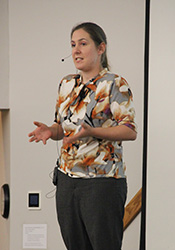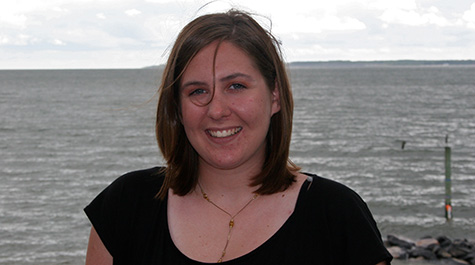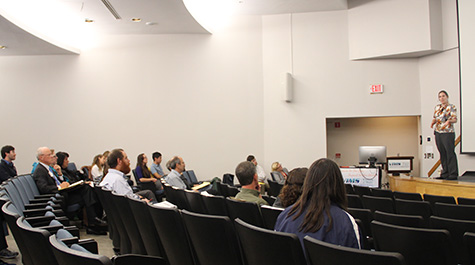VIMS student awarded prestigious EPA fellowship grant
Glaspie to explore habitat’s role in predator-prey interactions
Cassandra Glaspie of the Virginia Institute of Marine Science recently joined a select group of graduate students from across the nation as a recipient of a Science to Achieve Results (STAR) fellowship grant from the Environmental Protection Agency.
Glaspie—a Ph.D. student in William & Mary’s School of Marine Science at VIMS—received a 2-year, $84,000 fellowship for her study of the role that habitat plays in interactions between bivalves and their predators. Her research addresses the indirect effects of nutrient pollution on Chesapeake Bay, and explores a possible feedback loop that may lead to worsening effects.
Established in 1995, the STAR program provides funding for research grants and fellowships in numerous environmental science and engineering disciplines through a competitive solicitation process and independent peer review. This year the program awarded $8.6 million to 105 graduate students in institutions from Alaska to Florida.
“These fellowships are helping our next generation of scientists and engineers to earn advanced degrees in environmental sciences and conduct cutting-edge research," said Lek Kadeli, Acting Assistant Administrator for EPA's Office of Research and Development . "Through this support, EPA is ensuring that the U.S. will have the scientific knowledge to meet future environmental challenges, which will strengthen our nation's economy and security, while better protecting our health and environment."
Glaspie admits she was surprised when she found out she received the fellowship, but says that it meant a lot for her to know that her research is relevant to the nation.
“I think it’s important for the EPA to fund environmental scientists, especially those early in their career,” says Glaspie. “It allows the next generation to get the support they need to get a good education, and the freedom to study topics relevant to the protection and preservation of the environment.”
Glaspie’s dissertation research focuses on the interactions between clams, their predators—like crabs, fish, and rays—and habitats such as seagrass and oyster shell. “Seagrass roots and stems might hide clams from their predators, but in areas like the Bay where seagrass is in decline, this refuge may also be disappearing for some clam species,” she says.
Glaspie’s project will advance the current state of knowledge about nutrient pollution and consequent loss of seagrass habitat. “Understanding how changes in handling time and attack rate might affect interactions between a predator and its prey is essential to predict what effects global change will have on marine communities and ecosystem services,” she says.
Glaspie’s advisor, VIMS Associate Research Professor Rochelle Seitz, says Glaspie is eminently deserving of the fellowship. “The project Cassie chose for her dissertation research is unique and at an advanced level,” says Seitz. “I expect her work to help inform clam-restoration projects, to be published in top ecological journals, and to have a strong impact on the field of environmental science.”
“Very few studies examine the mechanisms behind predator-prey interaction,” adds Glaspie. “This study is particularly timely because it quantifies a shift in the functional response of benthic predators due to changes that are likely to happen in nutrient-polluted systems.”
“Cassie has the critical mindset to achieve great things with her research, and I’m excited to see where this fellowship will lead her,” says Seitz. “I think this is a great opportunity that I know she will take advantage of.”
Next year will mark 20 years of EPA’s commitment to STEM disciplines through funding STAR fellowship students. Since its inception, the program has awarded fellowships to 1,884 students, totaling approximately $65 million in funding.
Overall, according to an EPA press release, this year’s STAR fellowships will support scientists and engineers who are working to
- mitigate the impacts of climate change on plant communities by transforming the way we restore wetlands,
- improve our understanding of where and why harmful algal blooms occur by examining the way nutrients move through river systems,
- investigate how climate change waterborne human pathogens and antibiotic-resistant bacteria,
- study the interaction between pollutants and infectious disease, and
- classify and restore Pacific Northwest streams to improve water quality and fish habitat.




